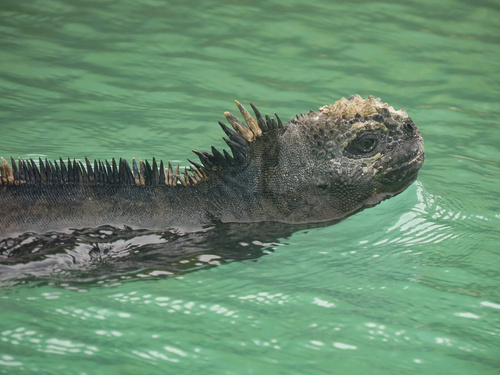
Marine Iguana
The Marine Iguana, Amblyrhynchus cristatus, thrives in the Galápagos, showcasing a unique adaptation to marine life. With rugged skin and a flat tail aiding its aquatic habitat, it feeds on algae, playing a crucial ecological role. Its salt-expelling snorts are a distinctive survival trait.
60 years
Lifespan
1.0 - 75.0 kg
Weight
Length: 20 - 38 cm
Size
Black
Color
3-8 years
Age of Sexual Maturity
24 mph
Top Speed
Vulnerable
Conservation Status
Decreasing
Population Trend
Characteristics
The Amblyrhynchus cristatus, commonly known as the Marine Iguana, is the only lizard adapted to life in the ocean. It is found only on the Galápagos Islands. Recognizable for its dark, rough skin and flat tail, it has sharp claws for gripping rocks underwater while feeding on algae. These iguanas are known for their unique ability to expel salt from their nostrils after ingesting seawater.
Distribution Range of the Marine Iguana
Amblyrhynchus cristatus, commonly known as the Marine Iguana, is endemic to the Galápagos Islands, an archipelago located in the Pacific Ocean, about 1,000 kilometers (620 miles) off the coast of Ecuador in South America. The species is found on most of the islands within the archipelago.
Marine Iguana's Habitat
Environmental Conditions
Marine Iguanas inhabit rocky shorelines and coastal areas where they bask on volcanic rocks. They are adapted to a marine lifestyle, often found in intertidal zones. The climate in their habitat is equatorial and semi-arid, with temperatures ranging from 15°C to 30°C (59°F to 86°F). The islands experience two distinct seasons: a warm, wet season from January to May and a cooler, dry season from June to December.
Ecological Niche
Marine Iguanas are unique among modern lizards due to their ability to forage in the sea. They primarily feed on marine algae, which they scrape off rocks in shallow waters. Their ecological niche includes being the only marine reptile that feeds exclusively on underwater vegetation. To survive in their niche, they have developed adaptations such as flattened tails for swimming, strong limbs with sharp claws for clinging to rocks, and specialized glands to expel excess salt ingested while feeding.
Copyright @ Nature Style Limited. All Rights Reserved.
 English
English